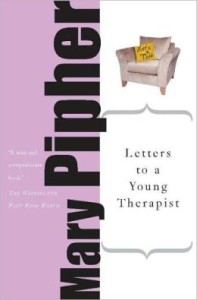The end of grad school, as it turns out, is the polar opposite of conducive to reading for leisure (and to sleeping, and to eating food fit for human beings, for the record).
It is with joy, then, and multiple bowls of movie theater butter popcorn that I read Letters to a Young Therapist, assigned (but enjoyable) reading for my internship class.
The book, by psychologist Mary Pipher, is a collection of letters to Laura, a young therapist Pipher supervised. While it imparts the author’s wisdom to the young therapists who read it, one need neither be young nor a therapist to get something good from my favorite parts of the book.
Here are my favorite excerpts:
On silence:
“Therapy isn’t radio. We don’t need to constantly fill the air with sounds. Sometimes, when it’s quiet, surprising things happen.” -p. 42
On pain:
“Most of the craziness in the world–violence, addictions, and frenetic activity–comes from running from pain.” -p. 54
“The only thing worse than feeling pain is not feeling pain. Healthy people face their pain. When they are sad, they cry. When they are angry, they acknowledge they are angry.” -p. 54
“The capacity to tolerate pain and sorrow is an under-appreciated virtue.” -p. 71
On happiness:
“Happiness bears almost no relationship to good fortune. … As my Uncle Otis put it, ‘Most people are about as happy as they make up their minds to be.'” -p. 58
“Satisfying lives are about much more than the absence of tragedy. They are about appreciating what we have.” -p. 60
On dating:
“…dating in America in the twenty-first century unhinges us all.” -p. 87
“Teenagers receive more lessons on driving a car than on dating and making relationships work.” -p. 89
On family:
“Family rituals strengthen families. One of my favorites is the high-low report at dinner, in which everyone at the table tells about the best and worst thing that happened that day.” -p. 117
– – – –
Click here to learn more about Mary Pipher’s book.
Disclosure: This post contains affiliate links. So, if you click the links and purchase the products I recommend, I earn a little commission at no extra cost to you. And when you do, I am sincerely grateful.

